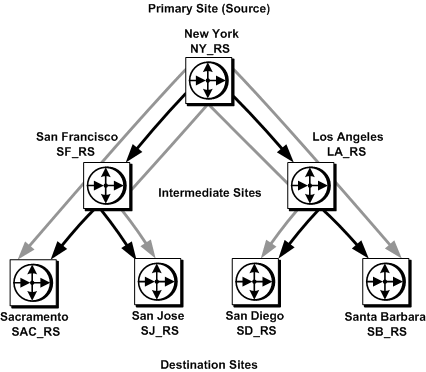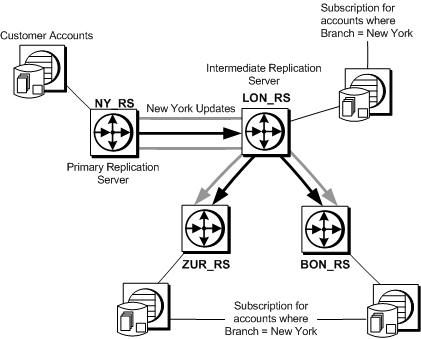A route with intermediate sites is called an indirect route.
The example for indirect routes shows a seven-site enterprise with a single primary site and six replicate sites. Each replicate site has a route originating at the primary site. Only two routes from the primary site are direct; four are indirect. The two intermediate sites each have two direct routes.
In this example, NY_RS to SAC_RS is an indirect route, based on the direct routes NY_RS to SF_RS and SF_RS to SAC_RS. In an indirect route, the source Replication Server sends messages for the destination Replication Server to an intermediate Replication Server, which makes use of a route (direct or indirect) to the destination Replication Server.
To create an indirect route, you create direct routes between each successive Replication Server along the intended indirect route. Once all the direct routes are in place, then you create the indirect route itself.
For example, to create the indirect route NY_RS to SAC_RS, first create the direct routes NY_RS to SF_RS and SF_RS to SAC_RS. Then create the indirect route based on the existing direct routes.
By setting up indirect routes, you reduce the amount of processing at the primary site and distribute the load among intermediate Replication Servers.
Direct Routes |
Indirect Routes |
|---|---|
NY_RS to SF_RS |
NY_RS to SAC_RS |
NY_RS to LA_RS |
NY_RS to SJ_RS |
SF_RS to SAC_RS |
NY_RS to SD_RS |
SF_RS to SJ_RS |
NY_RS to SB_RS |
LA_RS to SD_RS |
|
LA_RS to SB_RS |
When you use indirect routes, the primary Replication Server can route portions of subscriptions that are common to destination sites through the same intermediate site. When subscriptions overlap, the primary Replication Server is required to send only one message per row modification to the intermediate Replication Server that is common to the destination sites.
In this example of sites with overlapping subscriptions, the intermediate Replication Server in LON_RS receives row modification changes for customer accounts whenever changes occur at the bank headquarters in New York. The New York modifications are also required at branch bank replicate sites in Zurich and Bonn. Because LON_RS is set up to distribute changes to ZUR_RS and BON_RS, the NY_RS primary Replication Server sends only one copy of each change to LON_RS. The number of direct routes is also reduced through the use of the two indirect routes, NY_RS to ZUR_RS and NY_RS to BON_RS.
Although indirect routes are helpful for distributing computing resources among sites on the network, overall propagation of data is slowed somewhat because messages are queued by more than one Replication Server. It is better to use direct routes when there are few replicate sites. When using indirect routes, minimize the number of intermediate sites to obtain the best propagation times.

